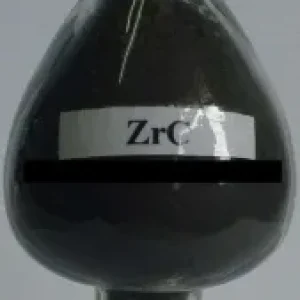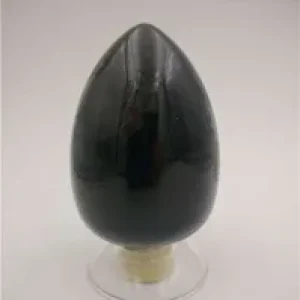Overview of Niobium Carbide NbC Powder
Niobium carbide NbC is an extremely hard refractory ceramic material used commercially for cutting tools. It is usually processed by sintering and is commonly used as a grain growth inhibitor additive in cemented carbides. Niobium carbide is a brown-gray metal powder with a purple luster. It is highly corrosion-resistant. Niobium carbide is one of the hardest technical compounds known. Niobium carbide, which has Young’s modulus of about 452 GPa, is a common product in micro-alloy steels because of its extremely low solubility in austenite, which is the lowest of all refractory metal carbides. This means that the micron-sized NbC precipitates are almost insoluble in the steel at all processing temperatures, and their location at grain boundaries helps prevent excessive grain growth in these steels. This is also a huge benefit for the base of micro-alloyed steel, as it is uniform and has a very fine grain size, ensuring toughness and strength.
Product Performance of Niobium Carbide NbC Powder
Niobium carbide NbC powder is a dark gray-brown powder with a cubic crystal structure and a metallic luster. It is stable at 1000 to 1100 °C and rapidly oxidizes to niobium pentoxide above 1100 °C.
Niobium carbide NbC powder has good chemical stability and high-temperature performance. It is a high melting point and high hardness material.
Niobium carbide NbC powder is insoluble in cold and hot hydrochloric acid, sulfuric acid, and nitric acid, and it is soluble in hot hydrofluoric acid and nitric acid mixed solution.
Niobium carbide NbC powder is easily melted in compounds such as titanium carbide, zirconium carbide, and tungsten carbide, and together form a homogeneous solid solution mixture, a commonly used cemented carbide additive.
Technical Parameter of Niobium Carbide NbC Powder
|
Product Name |
MF | Purity | Particle Size | Bulk Density | Melting Point | Color |
| Niobium Carbide | NbC | 99.5% | 2-4um, <1um | 7.6 g/cm3 | 3500℃ |
Gray Black |
Production Process of Niobium Carbide NbC
Niobium pentoxide reduction method:
Niobium carbide can be prepared by heating niobium oxide in a vacuum at 1800℃ and adding coke.
In industry, niobium carbide is usually prepared with niobium pentoxide and carbon black as raw materials. Will first proportion of niobium pentoxide and carbon black by carbide material, fully mixing, the load in the graphite crucible, with high-frequency electric furnace under the condition of hydrogen gas or vacuum heating to 1600 ~ 1800 ℃, for the first time, carbide and then adding carbon black, make its mix, under hydrogen gas or vacuum heating to 1800 ~ 1900 ℃, second carbide, This is niobium carbide.
Applications of Niobium Carbide NbC Powder
As a partial substitute for tantalum carbide, NbC powder is widely used in high-temperature refractory materials and carbide additives
- As a carbide additive, it is ternary and quaternary carbide solid solution components, such as WC-NBC-C ternary system, etc. It can also be used as a purple artificial gem.
- Used for the production of wear-resistant film and semiconductor film. It can also be used as raw material to produce molybdenum carbide. It can be used to manufacture special alloys and engineering ceramics without chromium.
Company Profile
My Carbides is a trusted global chemical material supplier & manufacturer with over 12-year-experience in providing super high-quality carbides and relatives products.
The company has a professional technical department and Quality Supervision Department, a well-equipped laboratory, and equipped with advanced testing equipment and after-sales customer service center.
If you are looking for high-quality Carbides, please feel free to contact us or click on the needed products to send an inquiry.
Storage Condition of Niobium Carbide NbC Powder
The damp reunion will affect NbC powder dispersion performance and using effects. Therefore, niobium carbide NbC powder should be sealed in vacuum packing and stored in a cool and dry room. The niobium carbide can not be exposed to air. In addition, the NbC powder should be avoided under stress.
Payment Methods of Niobium Carbide NbC Powder
L/C, T/T, Western Union, Paypal, Credit Card etc.
Shipment of Niobium Carbide NbC Powder
It could be shipped by sea, by air, or by reveal ASAP as soon as repayment receipt.
Package of Niobium Carbide NbC Powder
Vacuum packing, 1kg/bag, 25kg/barrel, or as requested.
FAQ
Q1: Is niobium carbide powder harmful to human body?
Answer: Niobium carbide powder itself is not toxic, but inhaling its dust for a long time may cause irritation or damage to the lungs. Therefore, when handling niobium carbide powder, you should wear protective masks and gloves and ensure that the workplace is well ventilated.
Q2: What is the density of niobium carbide powder?
Answer: The density of niobium carbide powder varies depending on the preparation method and particle size, but is usually between 7.56-8.47g/cm³.
Q3: What is the chemical stability of niobium carbide powder?
Answer: Niobium carbide powder has good chemical stability and is insoluble in strong acids such as hot and cold hydrochloric acid, sulfuric acid and nitric acid, but soluble in a mixed solution of hot hydrofluoric acid and nitric acid.
Q4: How is niobium carbide powder used in cemented carbide?
Answer: As an additive to cemented carbide, niobium carbide powder can significantly improve the hardness, wear resistance and high temperature performance of the alloy. It is commonly used in the manufacture of cutting tools, drill bits and molds, etc.
Q5: What effect does the particle size of niobium carbide powder have on performance?
Answer: The particle size of niobium carbide powder has a significant impact on its properties. Smaller particles increase the uniformity and density of the material, thereby increasing its hardness and wear resistance. However, particles that are too small may cause agglomeration and dispersion problems during processing. Therefore, when selecting niobium carbide powder, the appropriate particle size needs to be determined based on specific application scenarios and requirements.







